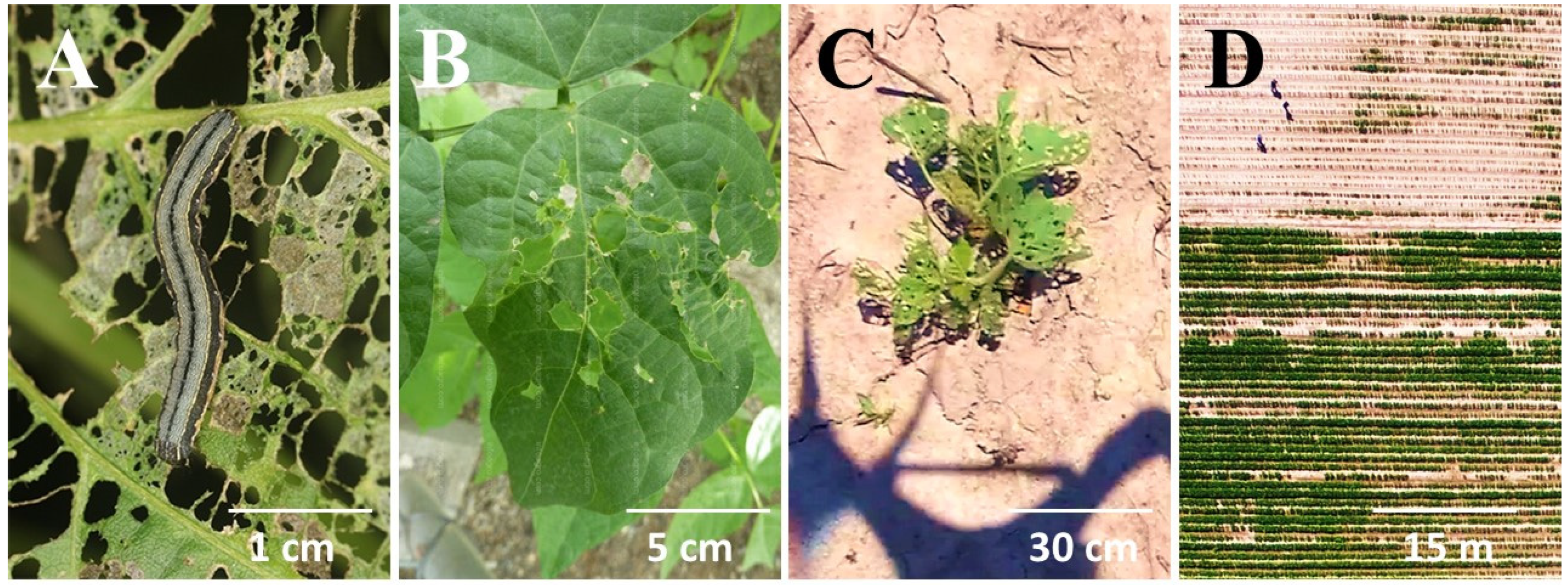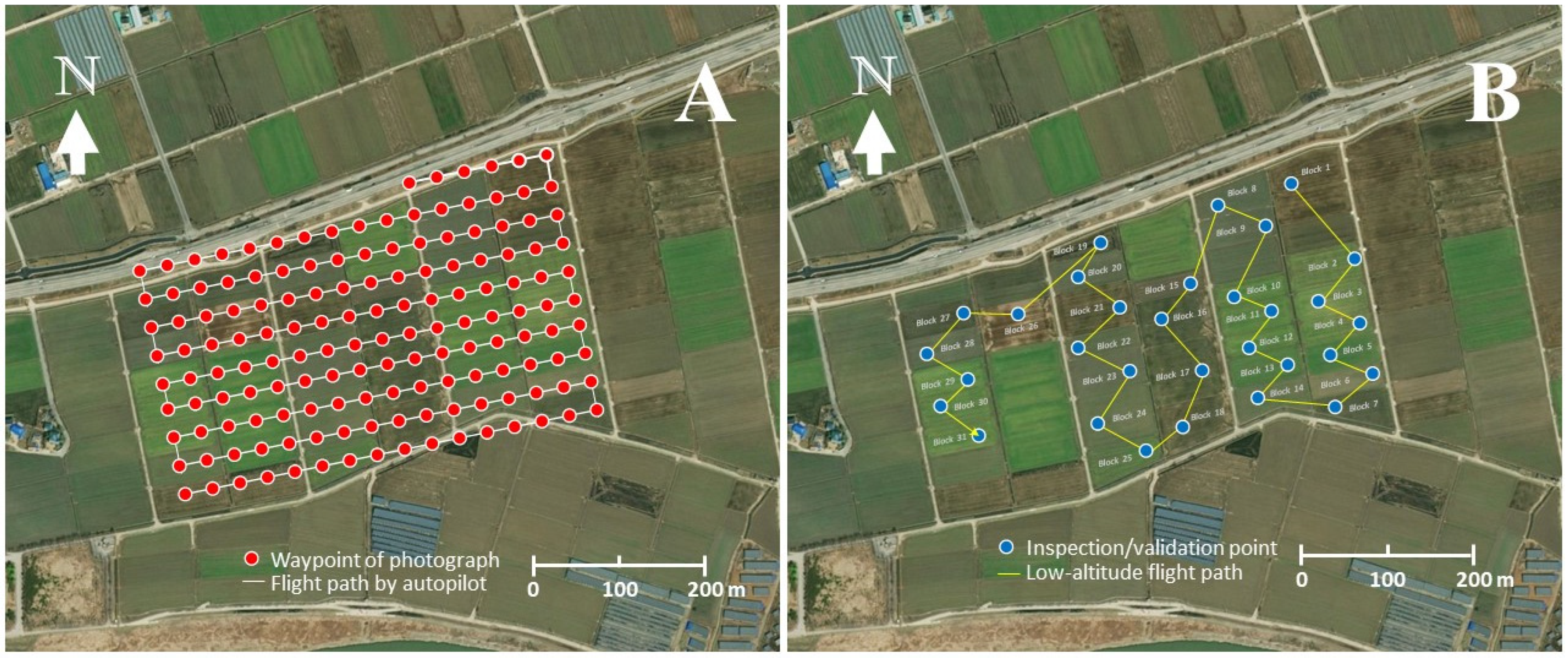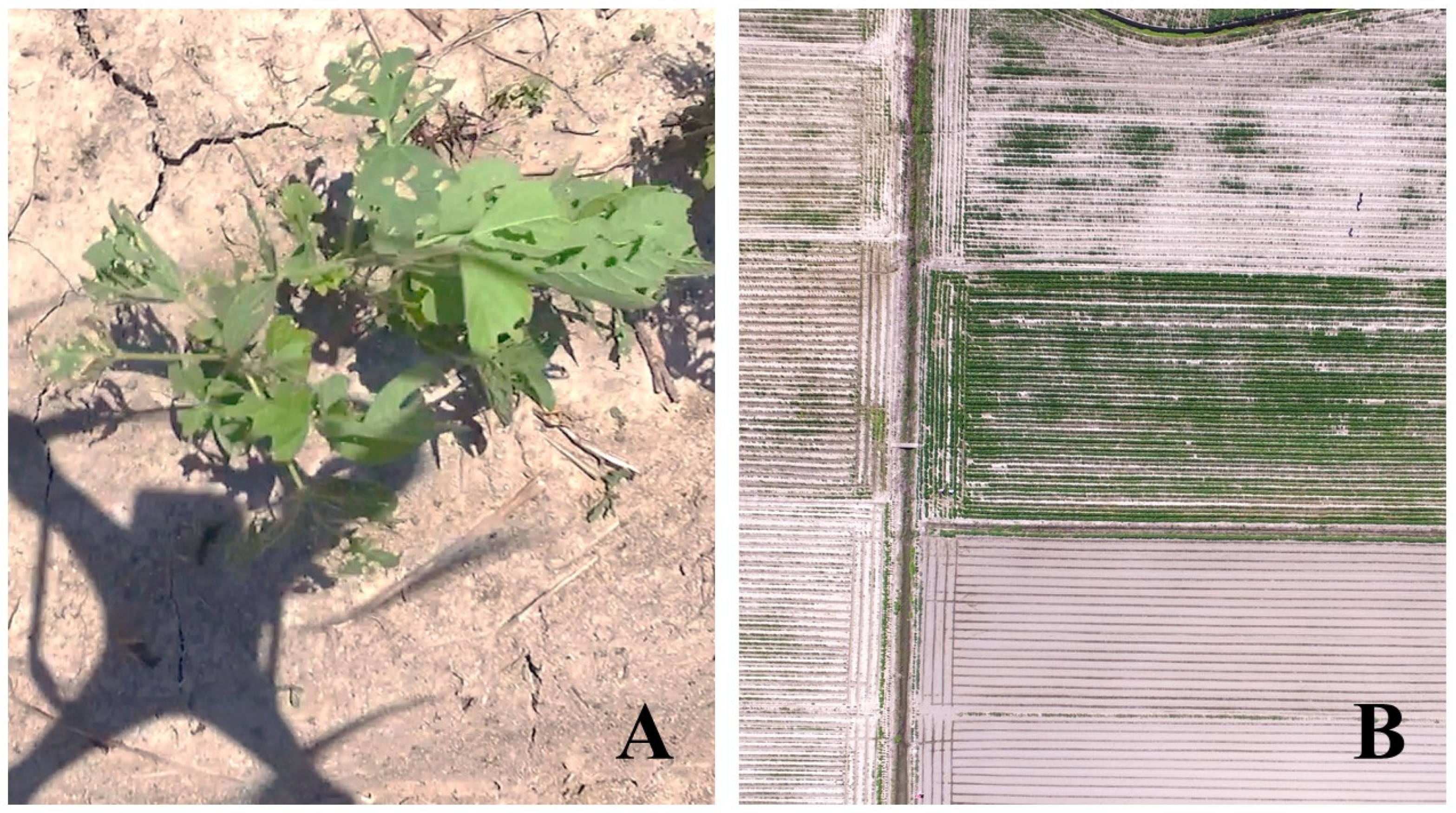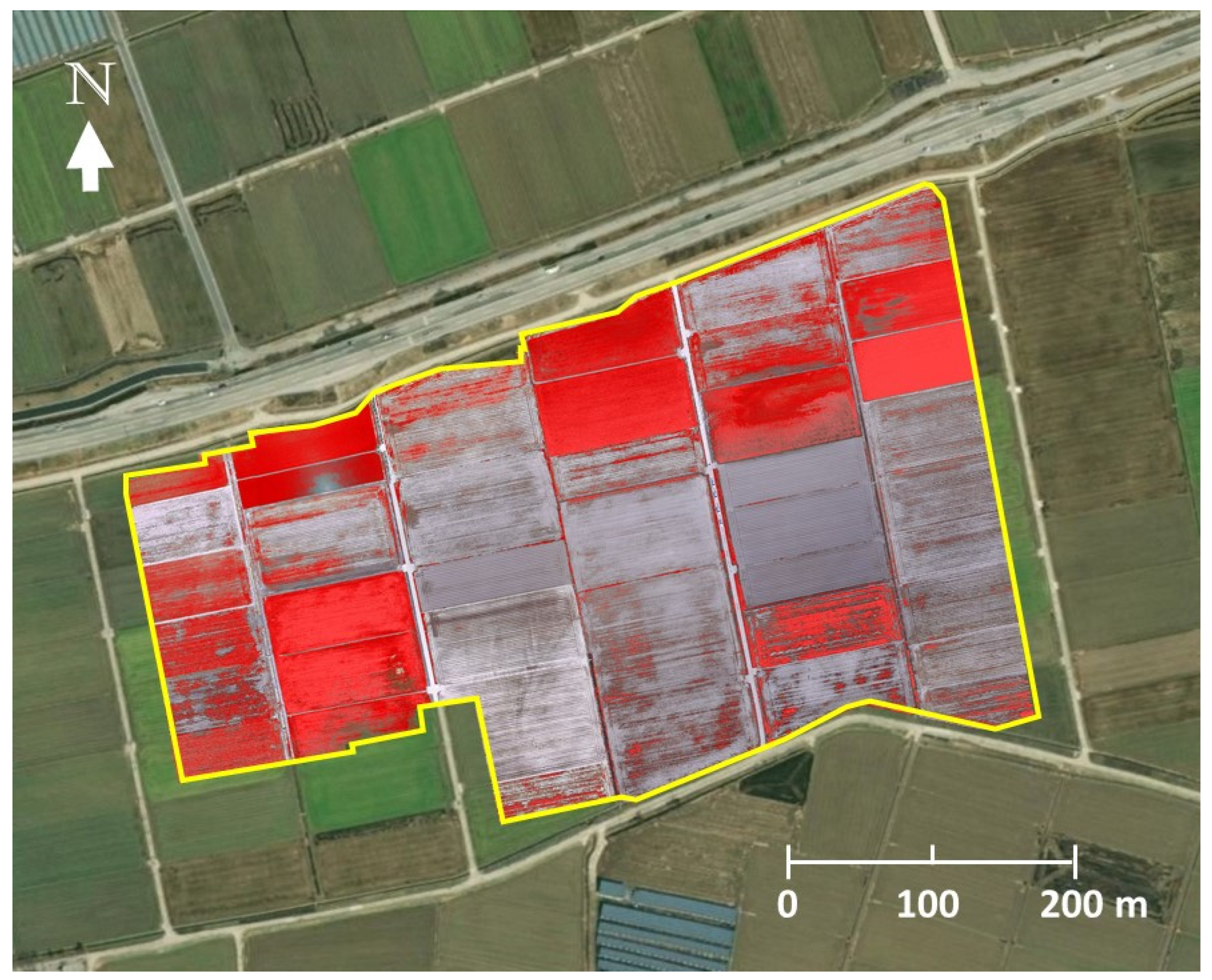Rapid Assessment of Insect Pest Outbreak Using Drones: A Case Study with Spodoptera exigua (Hübner) (Lepidoptera: Noctuidae) in Soybean Fields
Abstract
:Simple Summary
Abstract
1. Introduction
2. Materials and Methods
2.1. S. exigua Outbreak and Survey Site
2.2. Ground Survey and Damage Assessment
2.3. Aerial Survey and Damage Assessment
2.4. Image Processing and Analysis
2.5. Determining the Efficiency of the Aerial Survey with UAS
2.6. Spatial Patterns of Soybean Damage by S. exigua
2.7. Regional-Scale Soybean Damage by S. exigua
3. Results
3.1. Ground Survey and Damage Assessment
3.2. Aerial Survey and Image Analysis
3.3. Economic Analysis to Determine the Efficiency of Aerial Survey
3.4. Spatial Patterns of Soybean Damage by S. exigua
3.5. Regional-Scale Soybean Damage by S. exigua
4. Discussion and Conclusions
Supplementary Materials
Author Contributions
Funding
Data Availability Statement
Acknowledgments
Conflicts of Interest
References
- De Beurs, K.M.; Townsend, P.A. Estimating the effect of gypsy moth defoliation using MODIS. Remote Sens. Environ. 2008, 112, 3983–3990. [Google Scholar] [CrossRef]
- Jepsen, J.U.; Hagen, S.B.; Høgda, K.A.; Ims, R.A.; Karlsen, S.R.; Tømmervik, H.; Yoccoz, N.G. Monitoring the spatio-temporal dynamics of geometrid moth outbreaks in birch forest using MODIS-NDVI data. Remote Sens. Environ. 2009, 113, 1939. [Google Scholar] [CrossRef]
- Rasmussen, J.; Nielsen, J.; Garcia-Ruiz, F.; Christensen, S.; Streibig, J.C. Potential uses of small unmanned aircraft systems (UAS) in weed research. Weed Res. 2013, 53, 242–248. [Google Scholar] [CrossRef]
- Torres-Sánchez, J.; López-Granados, F.; De Castro, A.I.; Peña-Barragán, J.M. Configuration and specifications of an unmanned aerial vehicle (UAV) for early site specific weed management. PLoS ONE 2013, 8, e58210. [Google Scholar] [CrossRef] [PubMed] [Green Version]
- Park, Y.-L.; Cho, J.R.; Seo, B.Y. Detection of Monema flavescens (Lepidoptera: Limacodidae) cocoons using small unmanned aerial system. J. Econ. Entomol. 2021, 114, 1925–1933. [Google Scholar] [CrossRef]
- Valicharla, S.K.; Li, X.; Greenleaf, J.; Turcotte, R.; Hayes, C.; Park, Y.-L. Precision detection and assessment of ash death and decline caused by the emerald ash borer using drones and deep learning. Plants 2023, 12, 798. [Google Scholar] [CrossRef] [PubMed]
- Park, Y.-L.; Gururajan, S.; Thistle, H.; Chandran, R.; Reardon, R. Aerial release of Rhinoncomimus latipes (Coleoptera: Curculionidae) to control Persicaria perfoliata (Polygonaceae) using an unmanned aerial system. Pest Manag. Sci. 2018, 74, 141–148. [Google Scholar] [CrossRef]
- Greenberg, S.M.; Sappington, T.W.; Legaspi, B.C.; Liu, T.-X.; Setamou, M. Feeding and life history of Spodoptera exigua (Lepidoptera: Noctuidae) on different host plants. Ann. Entomol. Soc. Am. 2021, 94, 566–575. [Google Scholar] [CrossRef]
- Azidah, A.A.; Sofian-Azirun, M. Life history of Spodoptera exigua (Lepidoptera: Noctuidae) on various host plants. Bull. Entomol. Res. 2006, 96, 613–618. [Google Scholar] [CrossRef]
- Pearson, A.C. Biology, Population Dynamics, and Pest Status of the Beet Armyworm (Spodoptera exigua) in the Imperial Valley of California. Ph.D. Thesis, University of California, Riverside, CA, USA, 1982. [Google Scholar]
- Idris, A.B.; Emelia, O. Development and feeding behaviour of Spodoptera exigua (Lepidoptera: Noctuidae) on different food plants. J. Biol. Sci. 2001, 1, 1161–1164. [Google Scholar] [CrossRef]
- Xia-Lin, Z.; Cong, X.P.; Wang, X.P.; Lei, C.L. A review of geographic distribution, overwintering and migration in Spodoptera exigua Hübner (Lepidoptera: Noctuidae). J. Entomol. Res. Soc. 2011, 13, 39–48. [Google Scholar]
- Zheng, X.L.; Wang, P.; Cheng, W.J.; Wang, X.P.; Lei, C.L.; Heckel, D. Projecting overwintering regions of the beet armyworm, Spodoptera exigua in China using the CLIMEX model. J. Insect Sci. 2012, 12, 13. [Google Scholar] [CrossRef] [PubMed] [Green Version]
- Prasad, Y.G.; Gayathri, M.; Prabhakar, M.; Jeyakumar, P.; Vennila, S.; Subba Rao, A.V.M.; Bhaskara Rao, I.; Rao, K.V.; Ramachandra Rao, G.; Rao, V.U.M. Population dynamics of Spodoptera litura outbreak on soybean vis a vis rainfall events. J. Agric. Meteorol. 2013, 15, 37–40. [Google Scholar]
- Wen, L.; Zhang, Y. Modelling of the relationship between the frequency of large-scale outbreak of the beet army worm, Spodoptera exigua (Lepidoptera: Noctuidae) and the wide-area temperature and rainfall trends in China. Acta Entomol. Sin. 2010, 53, 1367–1381. [Google Scholar]
- Salmani-Moghanlou, J.; Valizadegan, O.; Naseri, B. Spatial distribution pattern of Spodoptera exigua (Lepidoptera: Noctuidae) on sugar beet and advantage of site-specific spraying in the pest management. J. Entomol. Soc. Iran 2021, 41, 135–149. [Google Scholar]
- Navasero, M.V.; Navasero, M.M.; Cayabyab, B.; Ebuenga, M.D.; Candano, R.N.; Burgonio, G.A.S.; Bautista, N.M.; Aquino, E.M., Jr.; Gaspar, G.G. Investigation on the 2016 outbreak of the onion armyworm, Spodoptera exigua (Hubner) (Lepidoptera: Noctuidae), in onion growing areas in Nueva Ecija. Philipp. Entomol. 2017, 31, 151–152. [Google Scholar]
- Sacheon Agricultural Development and Technology Center (SADTC). 2007. Available online: http://m.4000nongwon.net/board/list.php?id=de_note&no=227&page=6&category=&Search=&search_word=&mode=view# (accessed on 20 April 2023).
- Capinera, J.L. Beet Armyworm, Spodoptera exigua (Hübner) (Insecta: Lepidoptera: Noctuidae); University of Florida Cooperative Extension Service, Institute of Food and Agricultural Sciences, EDIS: Gainesville, FL, USA, 1999. [Google Scholar]
- Chau, L.M. Integrated pest management: A strategy to control resistance of Spodoptera exigua and Helicoverpa armigera caterpillars to insecticides on soybean in the Mekong Delta. Pestic. Sci. 1995, 43, 255–258. [Google Scholar] [CrossRef]
- Hwang, J.H.; Park, B.R.; Kim, G.S.; Lee, S.G.; Kim, Y.G. Identification of an entomopathogenic fungus, Nomuraea rileyi ANU101, infecting the beet armyworm, Spodoptera exigua, in Korea. Kor. J. Mycol. 1995, 37, 139–143. [Google Scholar] [CrossRef] [Green Version]
- Gelernter, W.D.; Federici, B.A. Isolation, identification, and determination of virulence of a nuclear polyhedrosis virus from the beet armyworm, Spodoptera exigua (Lepidoptera: Noctuidae). Environ. Entomol. 1986, 15, 240–245. [Google Scholar] [CrossRef] [Green Version]
- Feng, H.Q.; Wu, K.M.; Cheng, D.F.; Guo, Y.Y. Radar observations of the autumn migration of the beet armyworm Spodoptera exigua (Lepidoptera: Noctuidae) and other moths in northern China. Bull. Entomol. Res. 2003, 93, 115–124. [Google Scholar] [CrossRef]
- Westbrook, J.K.; Eyster, R.S. Doppler weather radar detects emigratory flights of noctuids during a major pest outbreak. Rem. Sens. Appl. Soc. Environ. 2003, 8, 64–70. [Google Scholar] [CrossRef]
- SAS Institute. Using JMP Student Edition for Windows and Macintosh: The User’s Guide to Statistics with JMP Student Edition; SAS Institute: Cary, NC, USA, 2009. [Google Scholar]
- Shayestehmehr, H.; Karimzadeh, R. Geostatistical analysis of spatial distribution of Therioaphis maculata (Hemiptera: Aphididae) and coccinellid lady beetles (Coleoptera: Coccinellidae). J. Crop Prot. 2019, 8, 103–115. [Google Scholar]
- Isaaks, E.H.; Srivastava, R.M. Applied Geostatistics. Oxford University Press: New York, NY, USA, 1989. [Google Scholar]
- Grego, C.R.; Vieira, S.R.; Lourenção, A.L. Spatial distribution of Pseudaletia sequax Franclemlont in triticale under no-till management. Sci. Agric. 2006, 63, 321–327. [Google Scholar] [CrossRef]
- Perry, J.N. Spatial analysis by distance indices. J. Anim. Ecol. 1995, 64, 303–314. [Google Scholar] [CrossRef]
- Perry, J.N.; Winder, L.; Holland, J.M.; Alston, R.D. Red–blue plots for detecting clusters in count data. Ecol. Lett. 1999, 2, 106–113. [Google Scholar] [CrossRef]
- Mulla, D.J. Twenty five years of remote sensing in precision agriculture: Key advances and remaining knowledge gaps. Biosyst. Eng. 2013, 114, 358–371. [Google Scholar] [CrossRef]
- Xiang, H.; Tian, L. Development of a low-cost agricultural remote sensing system based on an autonomous unmanned aerial vehicle (UAV). Biosyst. Eng. 2011, 108, 174–190. [Google Scholar] [CrossRef]
- Zhang, C.; Kovacs, J.M. The application of small unmanned aerial systems for precision agriculture: A review. Prec. Agric. 2012, 13, 693–712. [Google Scholar] [CrossRef]
- Daponte, P.; De Vito, L.; Glielmo, L.; Iannelli, L.; Liuzza, D.; Picariello, F.; Silano, G. A review on the use of drones for precision agriculture. In IOP Conference Series: Earth and Environmental Science; IOP Publishing: Bristol, UK, 2019; Volume 275, p. 012022. [Google Scholar]
- Mogili, U.R.; Deepak, B.B.V.L. Review on application of drone systems in precision agriculture. Proc. Comp. Sci. 2018, 133, 502–509. [Google Scholar] [CrossRef]
- Park, Y.-L.; Lee, D.-H.; Cho, J.R.; Seo, B.Y.; Cho, Y.-S. Advances, limitations, and future applications of aerospace technology for apple IPM. Kor. J. Appl. Entomol. 2021, 60, 135–143. [Google Scholar]
- Kim, J.; Huebner, C.; Reardon, R.; Park, Y.-L. Spatially-targeted biological control of mile-a-minute weed using Rhinoncomimus latipes (Coleoptera: Curculionidae) and an unmanned aerial system. J. Econ. Entomol. 2021, 114, 1889–1895. [Google Scholar] [CrossRef] [PubMed]
- Garre, P.; Harish, A. Autonomous agricultural pesticide spraying UAS. In IOP Conference Series: Materials Science and Engineering; IOP Publishing: Bristol, UK, 2018; Volume 455, p. 012030. [Google Scholar]
- Tsouros, D.C.; Bibi, S.; Sarigiannidis, P.G. A review on UAV-based applications for precision agriculture. Information 2019, 10, 349. [Google Scholar] [CrossRef] [Green Version]
- Zhang, J.; Huang, Y.; Yuan, L.; Yang, G.; Chen, L.; Zhao, C. Using satellite multispectral imagery for damage mapping of armyworm (Spodoptera frugiperda) in maize at a regional scale. Pest Manag. Sci. 2015, 73, 335–348. [Google Scholar]
- Buchaillot, M.L.; Cairns, J.; Hamadziripi, E.; Wilson, K.; Hughes, D.; Chelal, J.; McCloskey, P.; Kehs, A.; Clinton, N.; Araus, J.L.; et al. Regional monitoring of fall armyworm (FAW) using early warning systems. Remote Sens. 2022, 14, 5003. [Google Scholar] [CrossRef]
- Information on Korean Alien Species. Spodoptera exigua; National Institute of Ecology: Seochon, Korea, 2022; Available online: https://kias.nie.re.kr/ (accessed on 20 April 2023).
- Park, Y.-L.; Krell, R.K.; Carroll, M. Theory, technology, and practice of site-specific insect pest management. J. Asia-Pac. Entomol. 2007, 10, 89–101. [Google Scholar] [CrossRef]
- Park, Y.-L.; Krell, R.K. Generation of prescription maps for curative and preventative site-specific management of bean leaf beetles (Coleoptera: Chrysomelidae). J. Asia-Pac. Entomol. 2005, 8, 375–380. [Google Scholar] [CrossRef]
- Oliveira, R.A.; Näsi, R.; Niemeläinen, O.; Nyholm, L.; Alhonoja, K.; Kaivosoja, J.; Jauhiainen, L.; Viljanen, N.; Nezami, S.; Markelin, L.; et al. Machine learning estimators for the quantity and quality of grass swards used for silage production using drone-based imaging spectrometry and photogrammetry. Remote Sens. Environ. 2020, 246, 111830. [Google Scholar] [CrossRef]
- Kamilaris, A.; Prenafeta-Boldú, F.X. A review of the use of convolutional neural networks in agriculture. J. Agric. Sci. 2018, 156, 312–322. [Google Scholar] [CrossRef] [Green Version]
- Dias, P.A.; Tabb, A.; Medeiros, H. Apple flower detection using deep convolutional networks. Comp. Ind. 2018, 99, 17–28. [Google Scholar] [CrossRef] [Green Version]









| Block | Model | Nugget | Sill | DD (%) | Range (m) | r2 | RSS |
|---|---|---|---|---|---|---|---|
| Block 1 | Exp. | 14,400 | 212,600 | 93.2 | 89 | 0.92 | 7.53 × 108 |
| Block 7 | Exp. | 101,000 | 416,400 | 75.7 | 281 | 0.98 | 8.00 × 108 |
| Block 8 | Sph. | 91,000 | 494,100 | 98.1 | 606 | 0.98 | 3.22 × 109 |
| Block 9 | Sph. | 100 | 149,700 | 99.9 | 129 | 0.86 | 3.20 × 108 |
| Block 13 | Sph. | 15,930 | 38,320 | 58.4 | 272 | 0.95 | 1.08 × 107 |
| Block 18 | Exp. | 48,100 | 344,300 | 86.0 | 257 | 0.98 | 1.49 × 109 |
| Block 19 | Gauss. | 99,200 | 223,000 | 55.5 | 111 | 0.94 | 5.73 × 108 |
| Block 20 | Exp. | 41,000 | 401,000 | 89.8 | 166 | 0.93 | 4.59 × 109 |
| Block 25 | Sph. | 15,200 | 118,900 | 87.2 | 257 | 0.94 | 2.57 × 108 |
| Block 26 | Exp. | 194,000 | 560,400 | 65.4 | 872 | 0.97 | 1.09 × 109 |
| Block 28 | Sph. | 100 | 150,600 | 99.9 | 163 | 0.84 | 7.82 × 108 |
| Block 29 | Sph. | 100 | 149,700 | 99.9 | 129 | 0.86 | 3.20 × 108 |
| Block 30 | Exp. | 8100 | 53,550 | 84.9 | 137 | 0.98 | 2.39 × 107 |
| Block 31 | Sph. | 9910 | 25,110 | 60.5 | 752 | 0.87 | 1.72 × 107 |
| Block | Ia | Pa | ||||
|---|---|---|---|---|---|---|
| Block 1 | 1.604 | 0.0095 | −1.495 | 1.445 | 0.0118 | 0.0213 |
| Block 7 | 1.846 | 0.0015 | −1.883 | 1.788 | 0.0021 | 0.0036 |
| Block 8 | 3.272 | 0.0003 | −2.190 | 2.190 | 0.0000 | 0.0003 |
| Block 9 | 2.132 | 0.0015 | −1.582 | 1.548 | 0.0074 | 0.0131 |
| Block 13 | 2.030 | 0.0008 | −1.911 | 1.815 | 0.0010 | 0.0038 |
| Block 18 | 5.742 | 0.0003 | −1.878 | 2.135 | 0.0003 | 0.0000 |
| Block 19 | 1.482 | 0.0633 | −1.444 | 1.336 | 0.0679 | 0.1074 |
| Block 20 | 1.518 | 0.0051 | −1.659 | 1.563 | 0.0015 | 0.0038 |
| Block 25 | 1.534 | 0.0279 | −1.533 | 1.377 | 0.0318 | 0.0667 |
| Block 26 | 2.736 | 0.0003 | −1.910 | 1.883 | 0.0003 | 0.0003 |
| Block 28 | 1.417 | 0.0287 | −1.413 | 1.257 | 0.0287 | 0.0918 |
| Block 29 | 2.132 | 0.0015 | −1.582 | 1.548 | 0.0074 | 0.0131 |
| Block 30 | 2.774 | 0.0003 | −2.816 | 2.510 | 0.0000 | 0.0000 |
| Block 31 | 1.702 | 0.0074 | −1.610 | 1.503 | 0.0144 | 0.0290 |
Disclaimer/Publisher’s Note: The statements, opinions and data contained in all publications are solely those of the individual author(s) and contributor(s) and not of MDPI and/or the editor(s). MDPI and/or the editor(s) disclaim responsibility for any injury to people or property resulting from any ideas, methods, instructions or products referred to in the content. |
© 2023 by the authors. Licensee MDPI, Basel, Switzerland. This article is an open access article distributed under the terms and conditions of the Creative Commons Attribution (CC BY) license (https://creativecommons.org/licenses/by/4.0/).
Share and Cite
Park, Y.-L.; Naharki, K.; Karimzadeh, R.; Seo, B.Y.; Lee, G.-S. Rapid Assessment of Insect Pest Outbreak Using Drones: A Case Study with Spodoptera exigua (Hübner) (Lepidoptera: Noctuidae) in Soybean Fields. Insects 2023, 14, 555. https://doi.org/10.3390/insects14060555
Park Y-L, Naharki K, Karimzadeh R, Seo BY, Lee G-S. Rapid Assessment of Insect Pest Outbreak Using Drones: A Case Study with Spodoptera exigua (Hübner) (Lepidoptera: Noctuidae) in Soybean Fields. Insects. 2023; 14(6):555. https://doi.org/10.3390/insects14060555
Chicago/Turabian StylePark, Yong-Lak, Kushal Naharki, Roghaiyeh Karimzadeh, Bo Yoon Seo, and Gwan-Seok Lee. 2023. "Rapid Assessment of Insect Pest Outbreak Using Drones: A Case Study with Spodoptera exigua (Hübner) (Lepidoptera: Noctuidae) in Soybean Fields" Insects 14, no. 6: 555. https://doi.org/10.3390/insects14060555
APA StylePark, Y.-L., Naharki, K., Karimzadeh, R., Seo, B. Y., & Lee, G.-S. (2023). Rapid Assessment of Insect Pest Outbreak Using Drones: A Case Study with Spodoptera exigua (Hübner) (Lepidoptera: Noctuidae) in Soybean Fields. Insects, 14(6), 555. https://doi.org/10.3390/insects14060555







